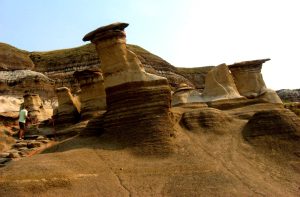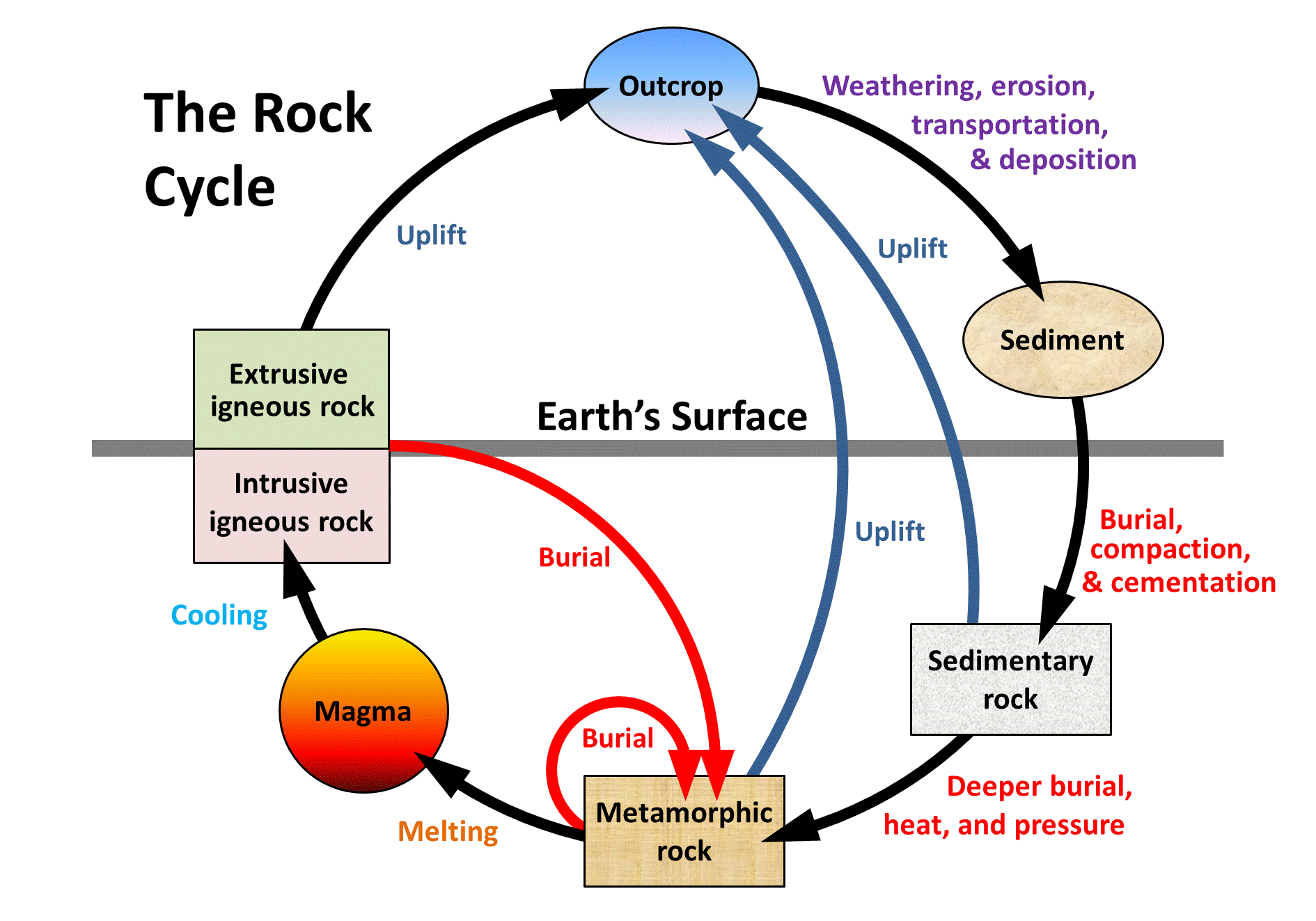Lab 5: Sediments and Sedimentary Rocks
Lab Structure
| Recommended additional work | None |
| Required materials | Mineral ID kit, Rock Kits 1 and 2, Mineral Kits 1 and 2, pencil |
Learning Objectives
By the end of this lab, you should be able to:
- Describe, in general terms, the main processes of mechanical and chemical weathering.
- Provide a brief summary of the main products of mechanical and chemical weathering.
- Explain the type of weathering processes that are likely to have taken place to produce a particular sediment deposit.
- Describe the differences between boulders, cobbles, pebbles, sand, silt, and clay, as well as explain the relationship between clast size and the extent to which clasts can be transported by moving water or by wind.
- Identify and describe the characteristics of the various types of clastic and chemical sedimentary rock based on their texture and mineralogy.
Key Terms
|
|
|

Weathering is what takes place when a body of rock is exposed to the “weather”—in other words, to the forces and conditions that exist at Earth’s surface. With the exception of volcanic rocks and some sedimentary rocks, most rocks are formed at some depth within the crust. There they experience relatively constant temperature, high pressure, no contact with the atmosphere, and little or no moving water. Once a rock is exposed at the surface, which is what happens when the overlying rock is eroded away, conditions change dramatically. Temperatures vary widely, there is much less pressure, oxygen and other gases are plentiful, and in most climates, water is abundant (Figure 5.0.1). The various processes related to uplift and weathering are summarized in the rock cycle in Figure 5.0.2.

In this lab, we will focus on three core concepts: the formation of sediment through the weathering of rocks at the Earth’s surface, the formation of sedimentary rocks from accumulated sediments, and the classification of various types of sedimentary rocks. The weathering and erosion of existing rocks at the Earth’s surface are the first two steps in the transformation of existing rocks into sedimentary rocks, and will be discussed during the introduction to the lab (you won’t want to be late to the lab!). The remaining steps in the formation of sedimentary rocks-transportation, deposition, burial, and lithification (Figure 5.0.2) – will be discussed in more detail from chapter 5.1 onwards.
In this course, we divide sedimentary rocks into two main types: clastic and chemical. Clastic sedimentary rocks are mainly composed of material that has been transported as solid fragments (clasts). Chemical sedimentary rocks are mainly composed of material that has been transported as ions in solution. It’s important not to assume that mechanical weathering leads only to clastic sedimentary rocks, while chemical weathering leads only to chemical sedimentary rocks. In most cases, millions of years separate the weathering and depositional processes, and both types of sedimentary rocks tend to include at least some material derived from both types of weathering.
Image Descriptions
Figure 5.0.2 image description: “The Rock Cycle.” The rock cycle takes place both above and below the Earth’s surface. The rock deepest beneath the Earth’s surface and under extreme heat and pressure is metamorphic rock. This metamorphic rock can melt and become magma. When magma cools, if below the Earth’s surface it becomes “intrusive igneous rock.” If magma cools above the earth’s surface it is “extrusive igneous rock” and becomes part of the outcrop. The outcrop is subject to weathering and erosion, and can be moved and redeposited around the earth by forces such as water and wind. As the outcrop is eroded, it becomes sediment which can be buried, compacted, and cemented beneath the Earth’s surface to become sedimentary rock. As sedimentary rock gets buried deeper and comes under increased heat and pressure, it changes into a metamorphic rock. Rocks in the rock cycle do not always make a complete loop. It is possible for sedimentary rock to be uplifted back above the Earth’s surface and for intrusive and extrusive igneous rock to be reburied and became metamorphic rock. [Return to Figure 5.0.2]
Media Attributions
- Figures 5.0.1, 5.0.2: © Steven Earle. CC-BY-4.0

